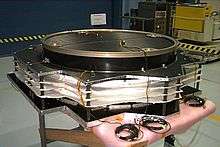Whipple shield
The Whipple shield or Whipple bumper, invented by Fred Whipple,[1] is a type of hypervelocity impact shield used to protect manned and unmanned spacecraft from collisions with micrometeoroids and orbital debris whose velocities generally range between 3 and 18 kilometres per second (1.9 and 11.2 mi/s).
Shield
In contrast to monolithic shielding of early spacecraft, Whipple shields consist of a relatively thin outer bumper spaced some distance from the main spacecraft wall. The bumper is not expected to stop the incoming particle or even remove much of its energy, but to break up and disperse it, dividing the original particle energy among many fragments that fan out between bumper and wall. The original particle energy is spread more thinly over a larger wall area, which is more likely to withstand it. A direct analogy is that a lighter bullet resistant vest is needed to stop a load of birdshot than a single rifle bullet with the same total mass and kinetic energy. Although a Whipple shield lowers total spacecraft mass, which is always desirable in spaceflight, the extra enclosed volume may require a larger payload fairing.
There are several variations on the simple Whipple shield. Multi-shock shields,[2][3] like the one used on the Stardust spacecraft, use multiple bumpers spaced apart to increase the shield's ability to protect the spacecraft. Whipple shields that have a filling in between the rigid layers of the shield are called stuffed Whipple shields.[4][5] The filling in these shields is usually a high-strength material like Kevlar or Nextel aluminium oxide fiber.[6] The type of shield, the material, thickness and distance between layers are varied to produce a shield with minimal mass that will also minimize the probability of penetration. There are over 100 shield configurations on the International Space Station alone,[7] with higher-risk areas having better shielding.
See also
References
- ↑ Whipple, Fred L. (1947), "Meteorites and Space Travel", Astronomical Journal, 52: 131, Bibcode:1947AJ.....52Q.131W, doi:10.1086/106009
- ↑ Cour-Palais, Burton G.; Crews, Jeanne L. (1990), "A Multi-Shock Concept for Spacecraft Shielding", International Journal of Impact Engineering, 10 (1–4): 135–146, doi:10.1016/0734-743X(90)90054-Y
- ↑ US 5067388, Crews, Jeanne L. & Burton G. Cour-Palais, "Hypervelocity Impact Shield", issued November 26, 1991
- ↑ Christiansen, Eric L.; Crews, Jeanne L.; Williamsen, Joel E.; Robinson, Jennifer H.; Nolen, Angela M. (1995), "Enhanced Meteoroid and Orbital Debris Shielding", International Journal of Impact Engineering, 17 (1–3): 217–228, doi:10.1016/0734-743X(95)99848-L
- ↑ US 5610363, Crews, Jeanne L.; Eric L. Christiansen & Jennifer H. Robinson et al., "Enhanced Whipple Shield", issued March 11, 1997
- ↑ 3M Nextel Ceramic Fabric Offers Space Age Protection (PDF), 3M Company, retrieved September 4, 2011
- ↑ Christiansen, Eric L. (2003), Meteoroid/Debris Shielding (PDF), Washington DC: National Aeronautics and Space Administration, p. 13, TP−2003-210788, archived from the original (Technical Report) on 2013-02-25
External links
- Brief descriptions of spacecraft shielding by NASA
- B.G. Cour-Palais' reminisces of the Apollo meteoroid protection program
- The Skylab meteoroid shield design and development
- ESA Giotto dust shield
- J.L. Crews' recounting of the invention of the multi-shock shield, p. 21-29
- Installing the Nextel/Kevlar blankets in the Destiny laboratory stuffed Whipple Shields
- Meteoroid/Debris Protection System Development at ESA for ATV and Columbus
- Hyper-velocity impact test at JAXA of Kibo's debris shield
